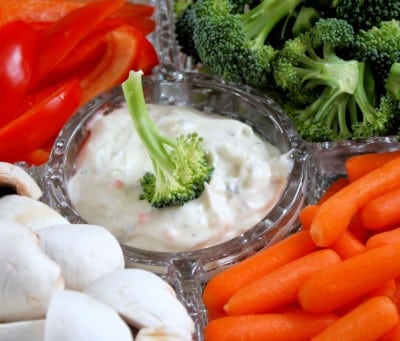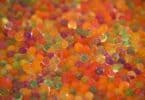As the mom of two picky kids, I am always looking for new ways to get them to eat more good foods. Last year we started juicing and I have been creating a lot of dishes that combine a variety of food groups together but I still don’t feel like my guys are getting enough fresh produce.
Earlier this week a study was released that found offering a dip alongside vegetables encourages kids to eat veggies they might normally push aside.
For their research the Center for Childhood Obesity Research at Pennsylvania State University asked 34 preschoolers to do a taste test of vegetables with and without a low-fat dip.
Only 10(31 percent) of the children liked a vegetable alone, while 22(64 percent) of the kids liked a vegetable when it was given with the flavored dip.
Also, only 2(six percent) of kids refused the vegetable and flavored dip, while 6(18 percent) refused the vegetable without any dip.
In another experiment, the researchers gave 27 preschoolers celery or squash – two veggies that aren’t normally popular with little ones. They found that kids ate about 15 grams of celery(about 2 sticks) and six grams of squash(handful).
When the vegetables were offered with dip, the kids ate more – about 25 grams of celery and about 15 grams of squash.
The research team points out that the dips were low in calories and given in small portions. Each serving was 3.5 tablespoons(50 calories, 4gms of fat and 90mgms of sodium).
“That’s what those extra calories are for, those discretionary calories we have each day, to try to make something healthy taste better to increase consumption,” Marlene Schwartz, of the Rudd Center for Food Policy and Obesity at Yale University, who was not involved in the study told Reuters.com
The American Heart Association recommends that children 4-8 should have 1 – 1.5 cups of vegetables a day.
“Food and nutrition practitioners can help the staff at childcare centers, kindergartens, and elementary schools enhance children’s acceptance and consumption of vegetables by pairing vegetables with small portions of reduced-fat, herb-flavored dips during snack and meal times,” the researchers wrote in their report.
In the past research has shown that kids will eat more fruit and vegetables when a family eats dinner together.
Ms. Schwartz says that parents should be more focused on getting children to be willing to try vegetables, than worrying about how much they consume daily.
“If you can get preschoolers to see themselves as people who try a bunch of different vegetables and try them in different ways and like vegetables, then you can really reinforce that way of seeing themselves and that’s going to help you in the long run,” she said.
I recently came across this great post at Parents.com that offers some practical tips on how to get kids eating more vegetables. I adapted a couple of them into our routine and found that when the kids were more involved they were excited to try new things. We also have a no-snack-before-dinner rule.
I wholeheartedly agree with this study as my kids tend to eat more of everything if dip is involved. Greek yogurt mixed with strawberry puree is a perfect dip for apples, pears or melon. I go the other way and do Greek yogurt with finely chopped cucumber, lemon, garlic, and dill for carrots, celery, or sliced red and yellow peppers. They love it and often try new products when they like what they are dipping it in. The key is to make sure that the dip is also nutritious. Hummus, Baba Ganoush, and Tzatziki are three good ones and are pretty easy to make.
How do you get your kids to eat their vegetables?







